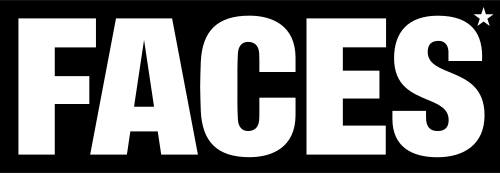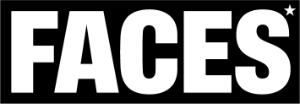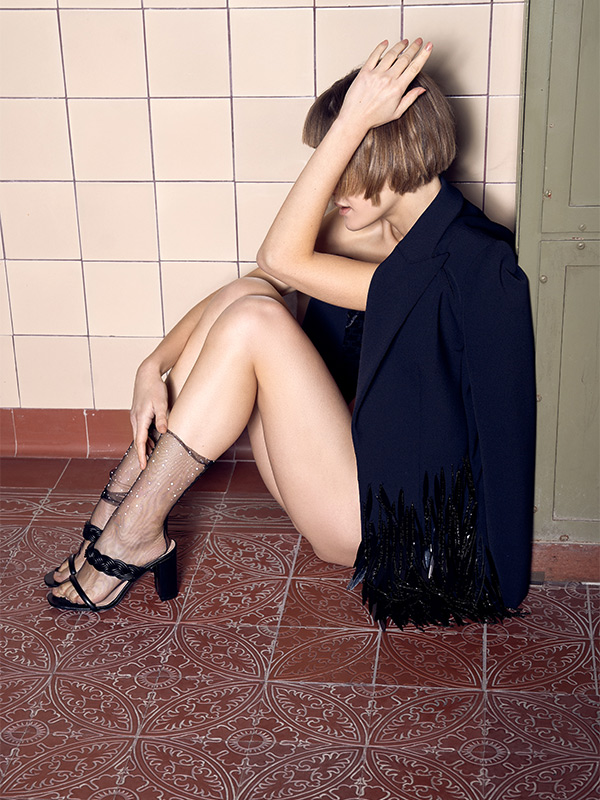Photography: Alex Lambrechts @alex_lambrechts
Model: Jasmin Brunner @jazbrunner
Production: Rogues Agency @roguesagency
Location: The Amber, Maldives @sailamber sailamber.com
Foreword by Alex Lambrechts
As far as I can remember, the photographer or art director deserves credit for the work created. Without the “muse” (in my creations), however, there is no art. Most of my source of inspiration and visualization comes from my muse and my dreams; and my muse shapes my dreams. The way Jasmin and I work together can be described as an artistic collaboration. She is the one who inspires my work and my personal reflection. She is my mirror. I use artistic expression to question myself, my human nature and my greater social responsibility in this context …
That’s why I’m making my photographic contribution to this story in the form of a love letter. But before I do, I have intentionally not retouched or edited ANY of the images in this story to ensure that this “love letter” is authentic. What you see is exactly what was scanned from the processed negatives, using a variety of film stocks and techniques to give a certain visceral feel and heightened realism …
This story is a faithful representation of our shared visions, created with a handful of my favorite vintage cameras and lenses (all from the 1950s and 1960s). As in life, with analog recordings we can’t look at the camera screen and repeat something, there are no “retakes”, we have to gradually get to the heart of the situation and move on to the next scene. This makes the experience raw and exciting.
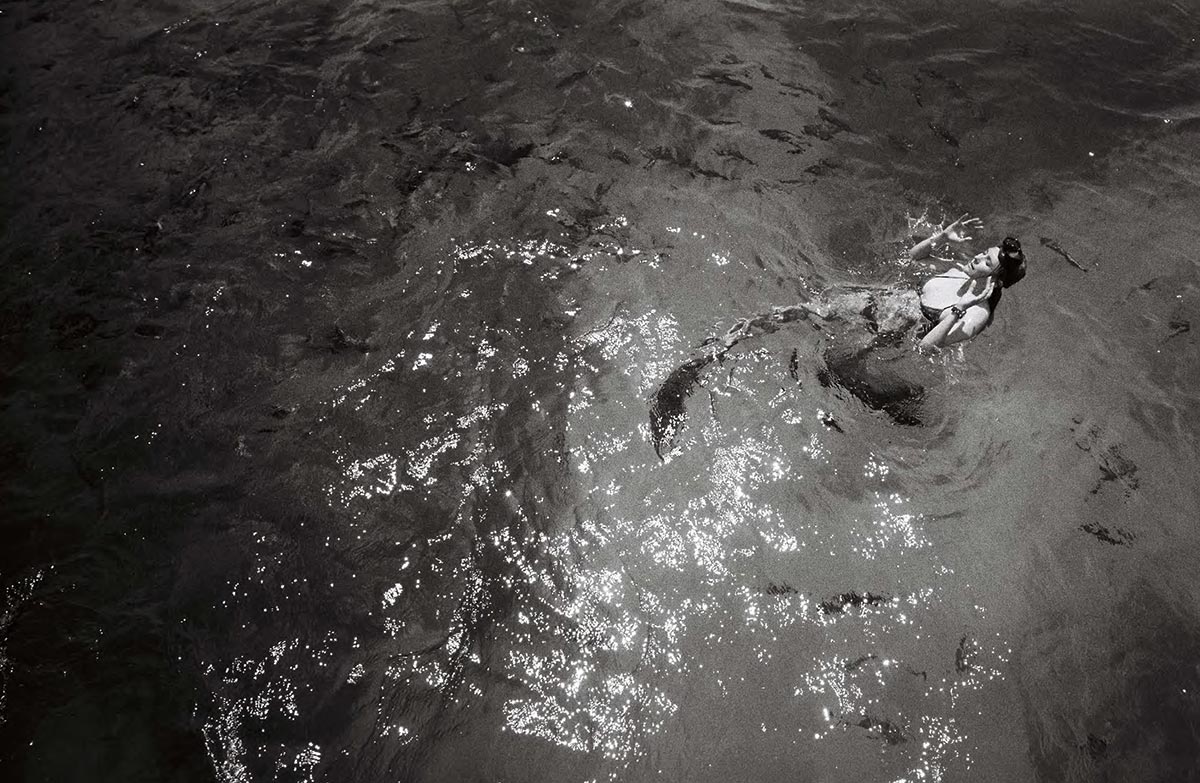
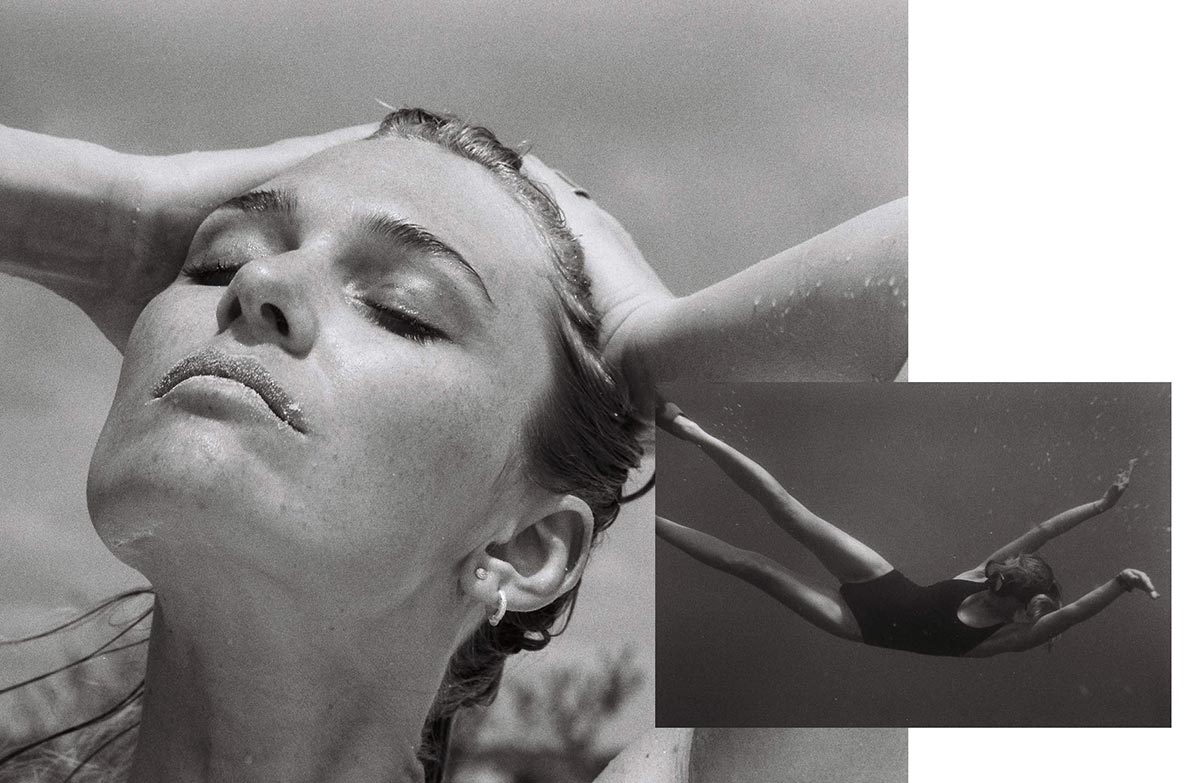
Earrings from TOM WOOD. Eye shadow from DIOR.
Right:
Swim dress from HERMÈS.
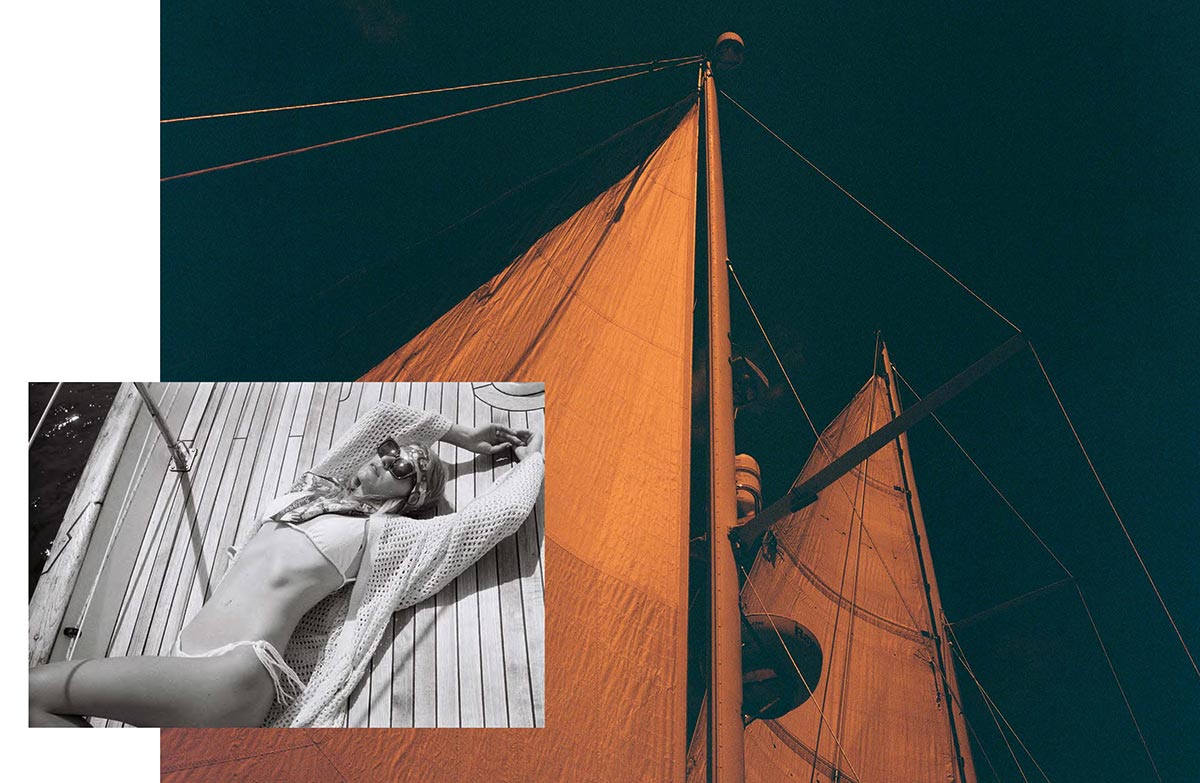
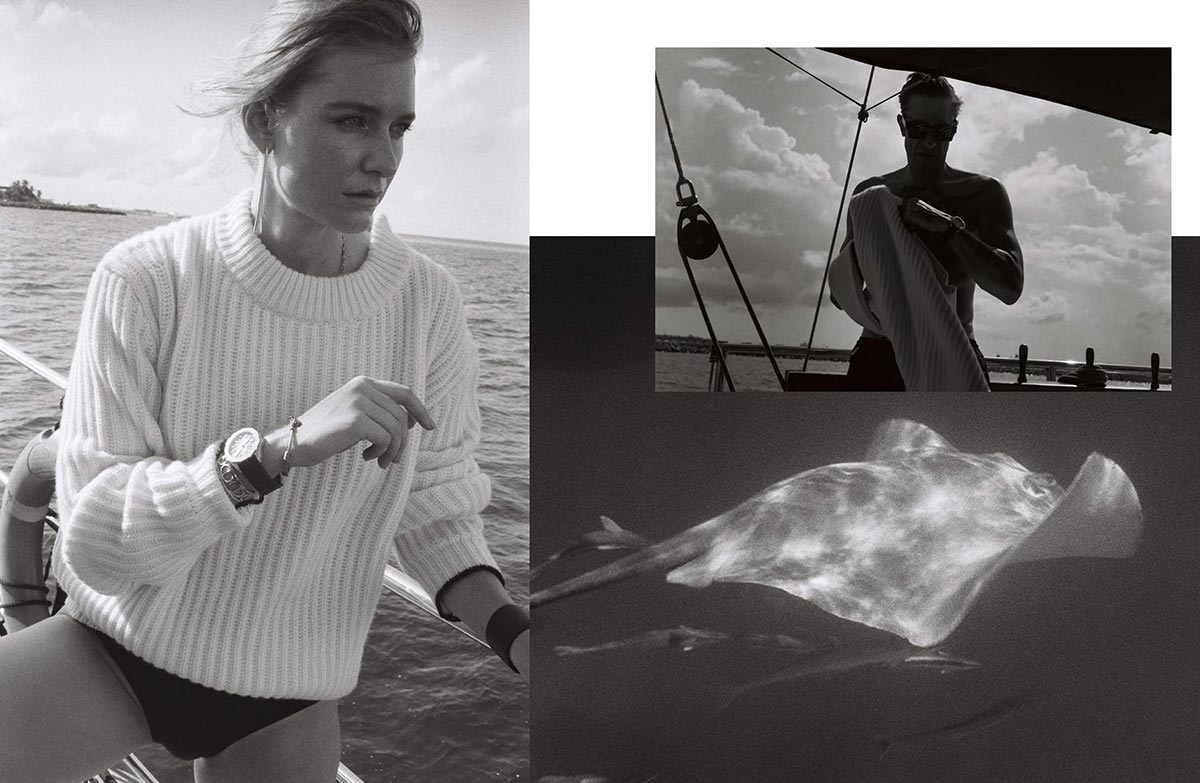
Sweater from ALEX LAMBRECHTS SPORT. Earrings from HERMÈS. Watch from TAG HEUER. Bracelets from BULGARI and HERMÈS
Right:
Sweater from ALEX LAMBRECHTS SPORT. Sunglasses from ROBERT LA ROCHE. Watch from TAG HEUER.
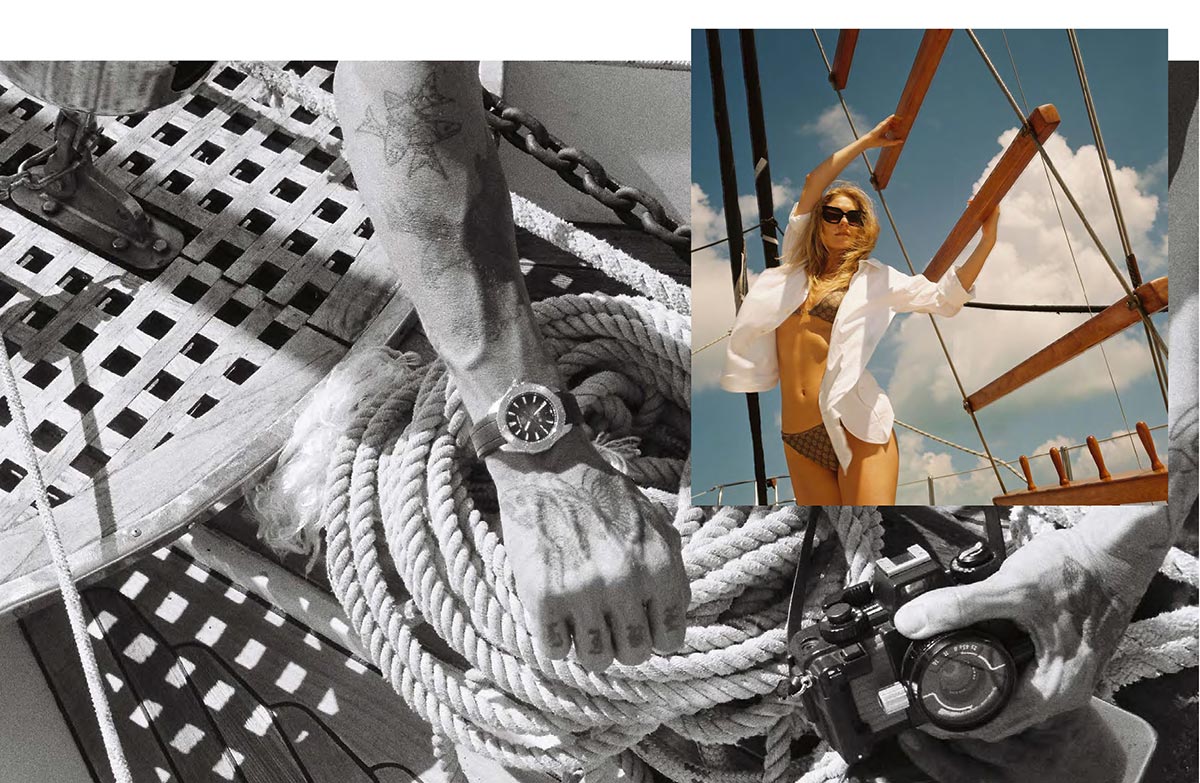
Watch from TAG HEUER. Underwater camera from NIKON.
Right:
Bikini from GUCCI. Shirt by RALPH LAUREN. Sunglasses from ROBERT LA ROCHE.

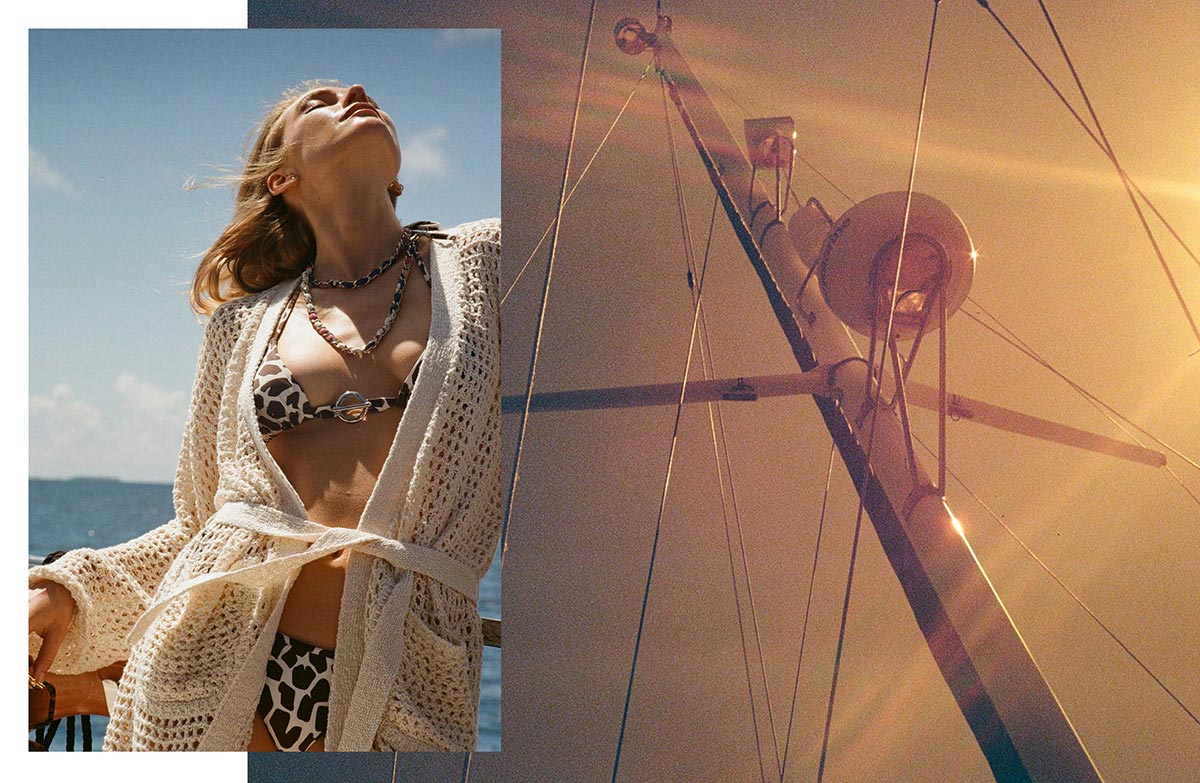
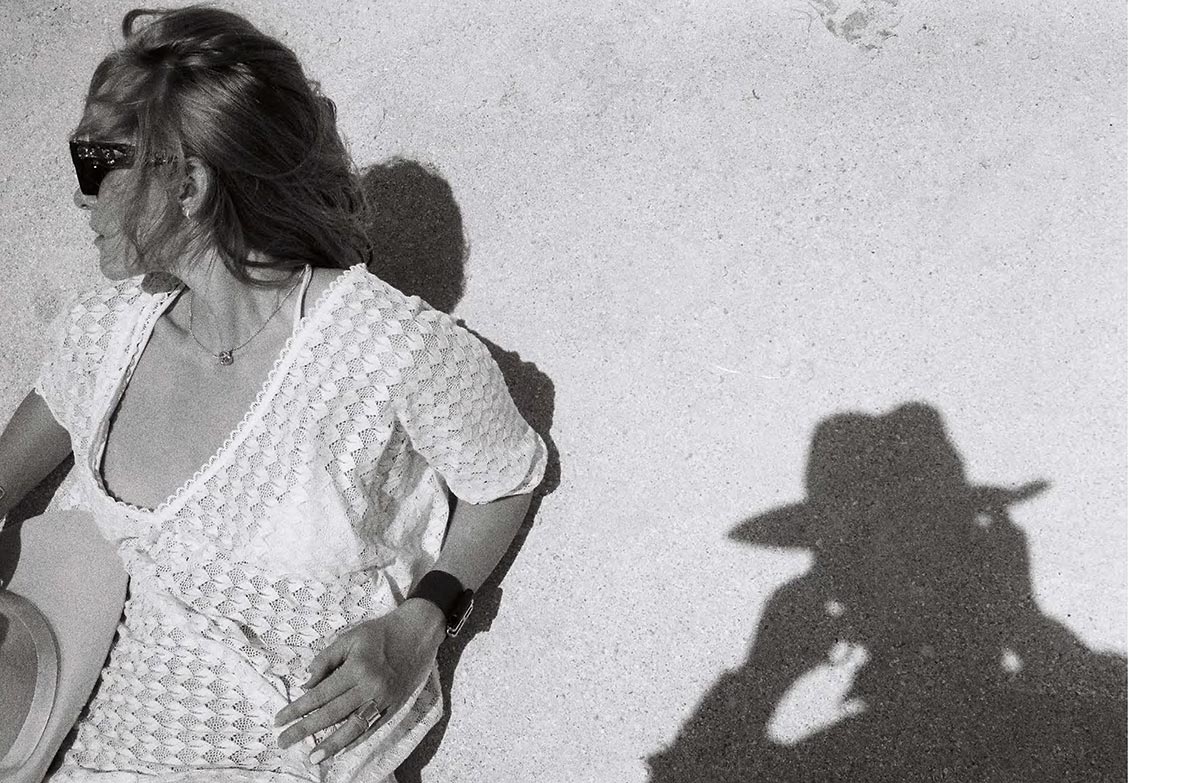
Hat in the shade:
Hat by ALEX LAMBRECHTS X SUPERDUPER.
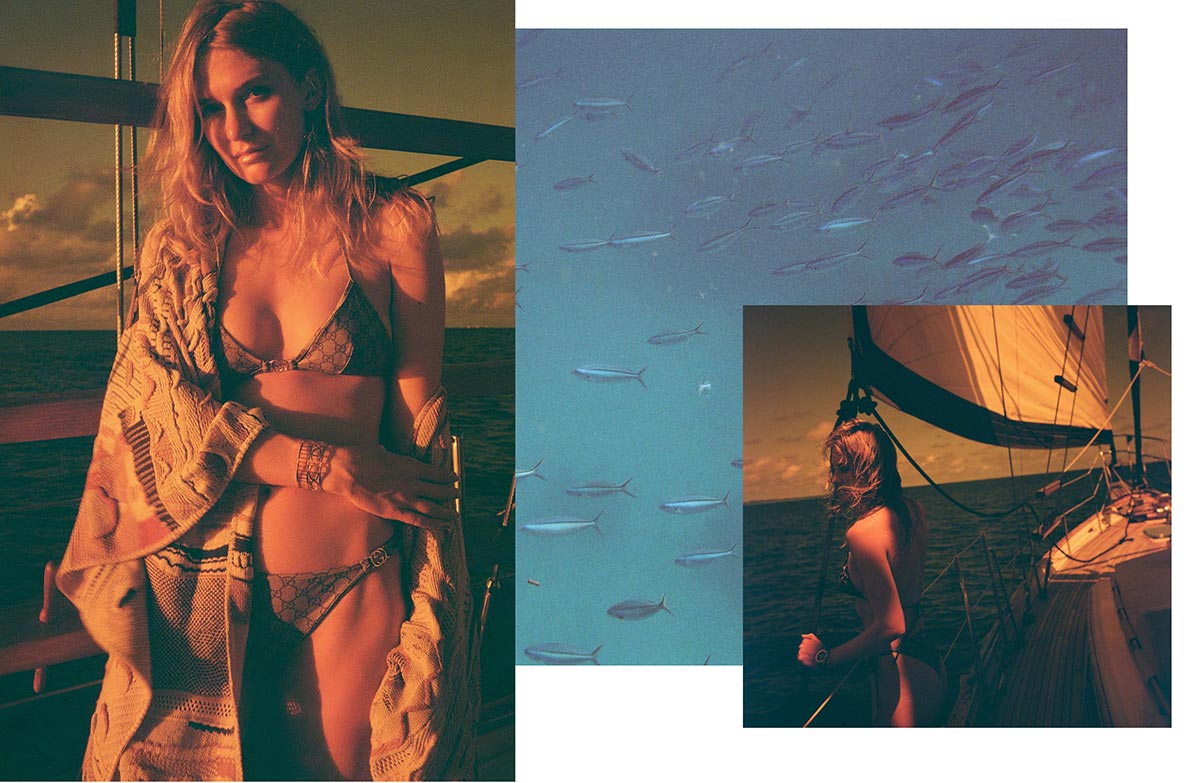
Bikini from GUCCI. Kimono from MES DEMOISELLES (via Jelmoli). Bracelet from HERMÈS. Beauty from ARMANI.
Right:
Watch from TAG HEUER.

Swim dress from HERMÈS. Watch from BULGARI.
Right:
Tunic from RICK OWENS. Shoes and bracelet from HEMRÈS. Narrow bracelet from BULGARI. Lipsticks from CHANEL BEAUTY and TOM FORD BEAUTY.
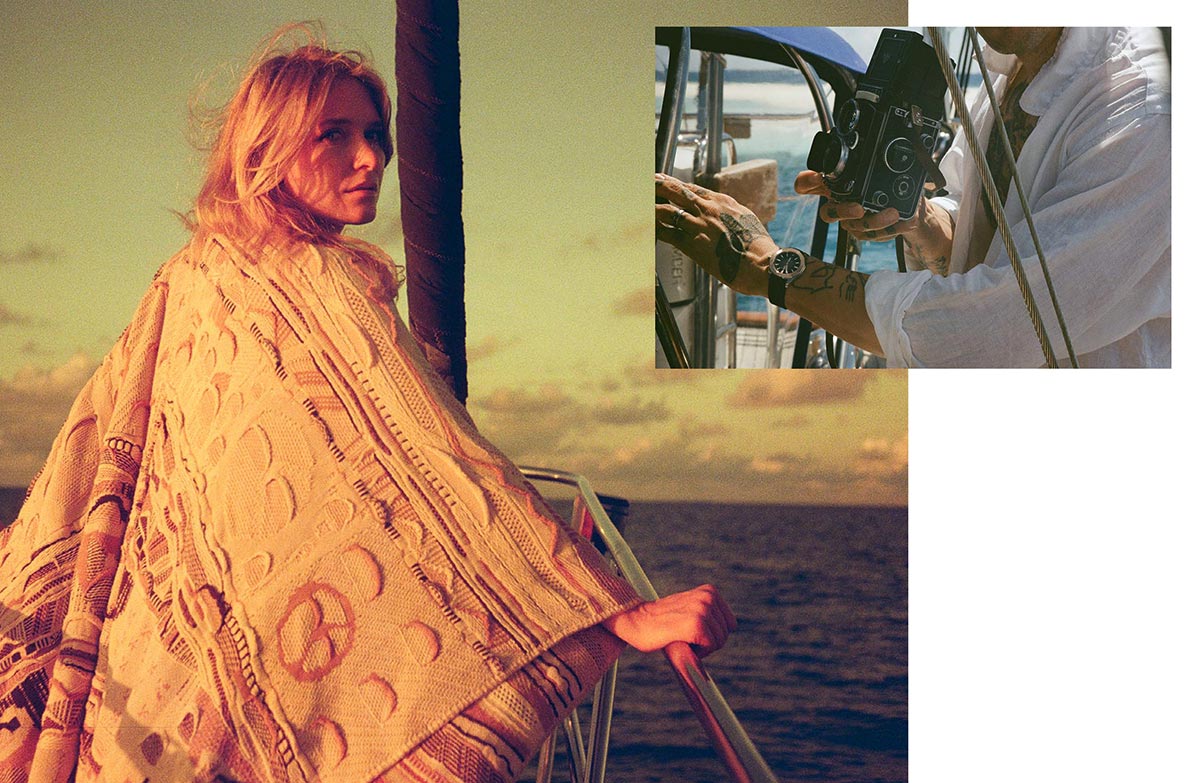
Kimono from MES DEMOISELLES (via Jelmoli).
Right:
Shirt by RALPH LAUREN. Watch from TAG HEUER. Camera from ROLLEIFLEX.
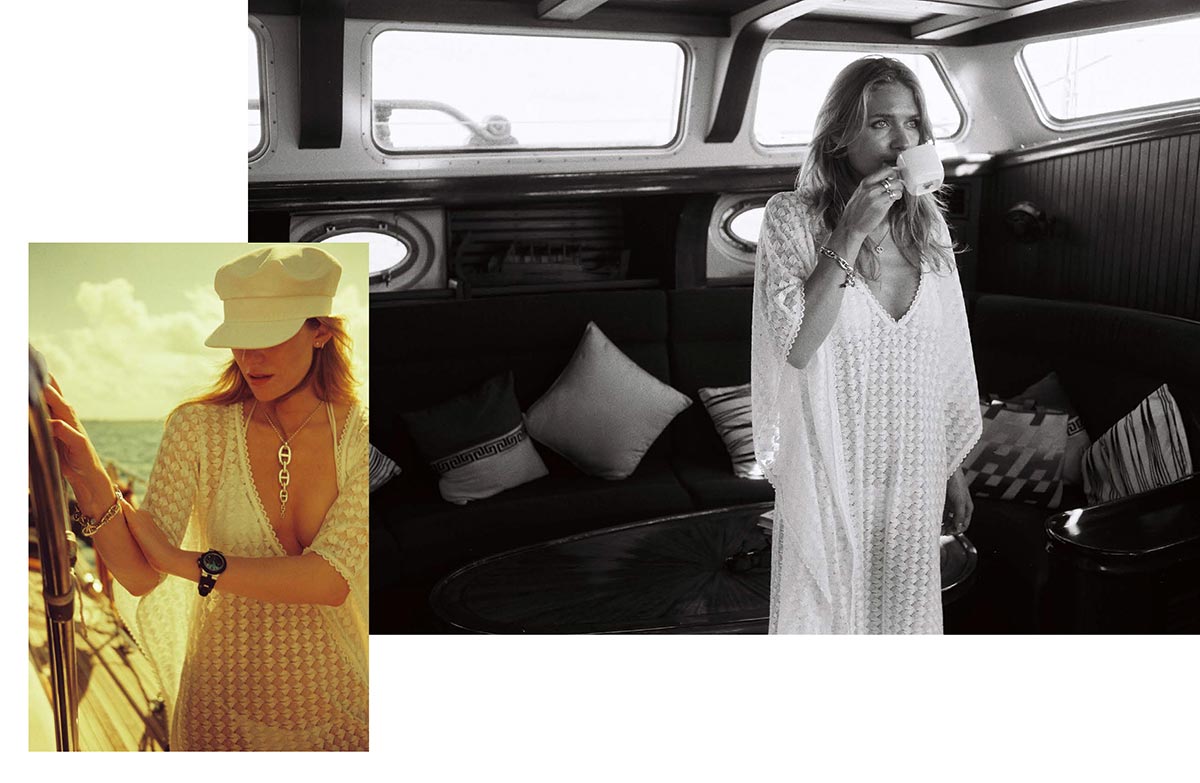
Kaftan from MELISSA ODABASH. Hat, necklace and bracelet from HERMÈS. Watch from BULGARI.
Right:
Kaftan from MELISSA ODABASH. Necklace by DIOR. Bracelet and bag from HERMÈS.

Swim dress from ERES. Earrings from necklace HERMÈS.
Right:
Bikini from CALVIN KLEIN
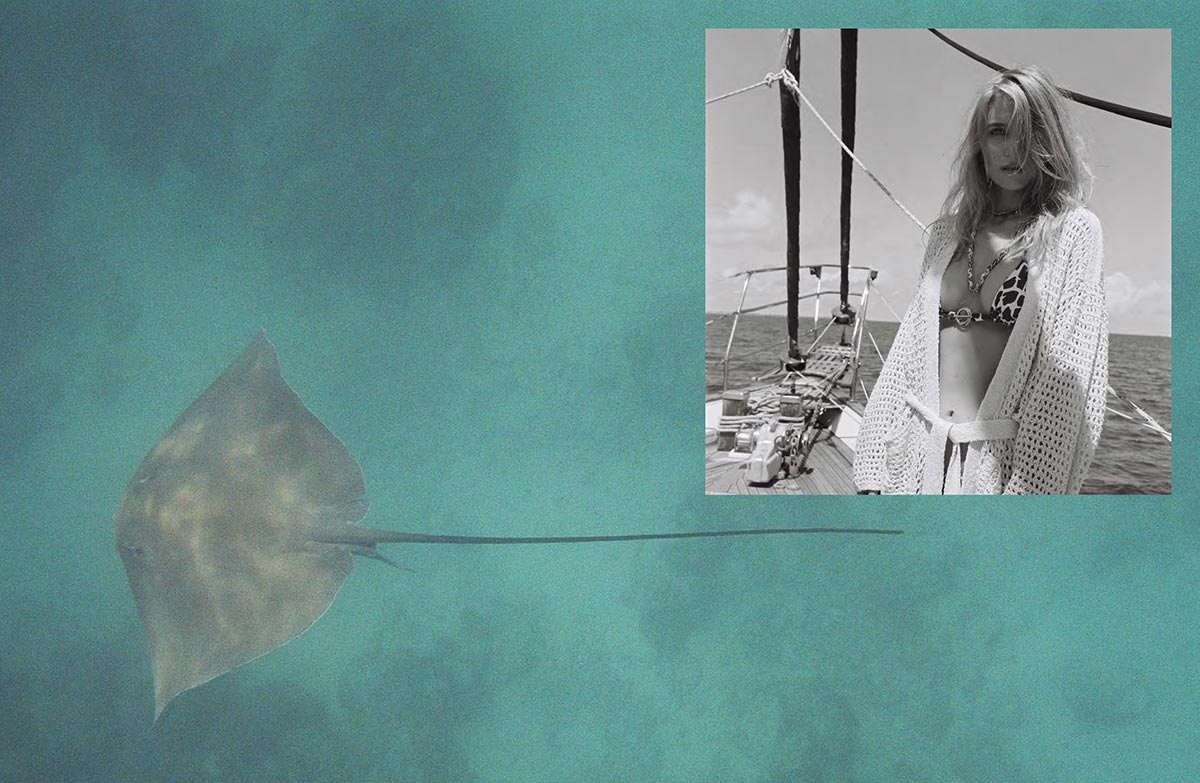
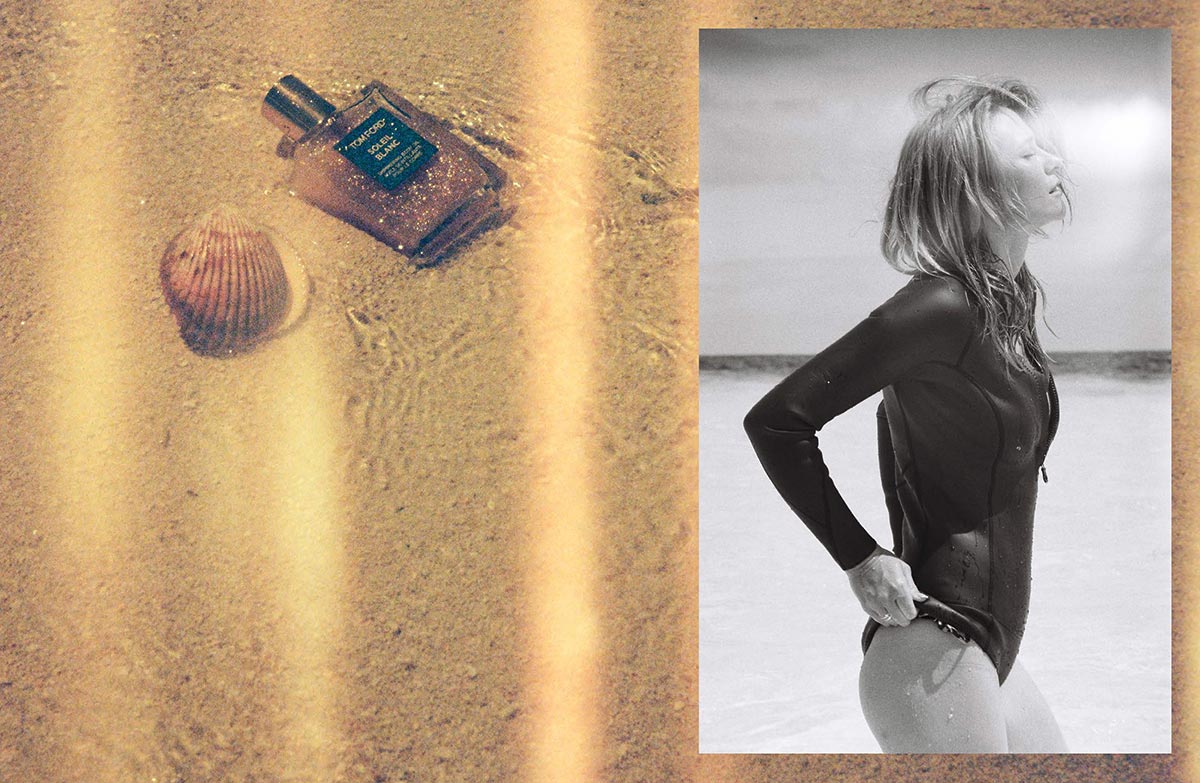
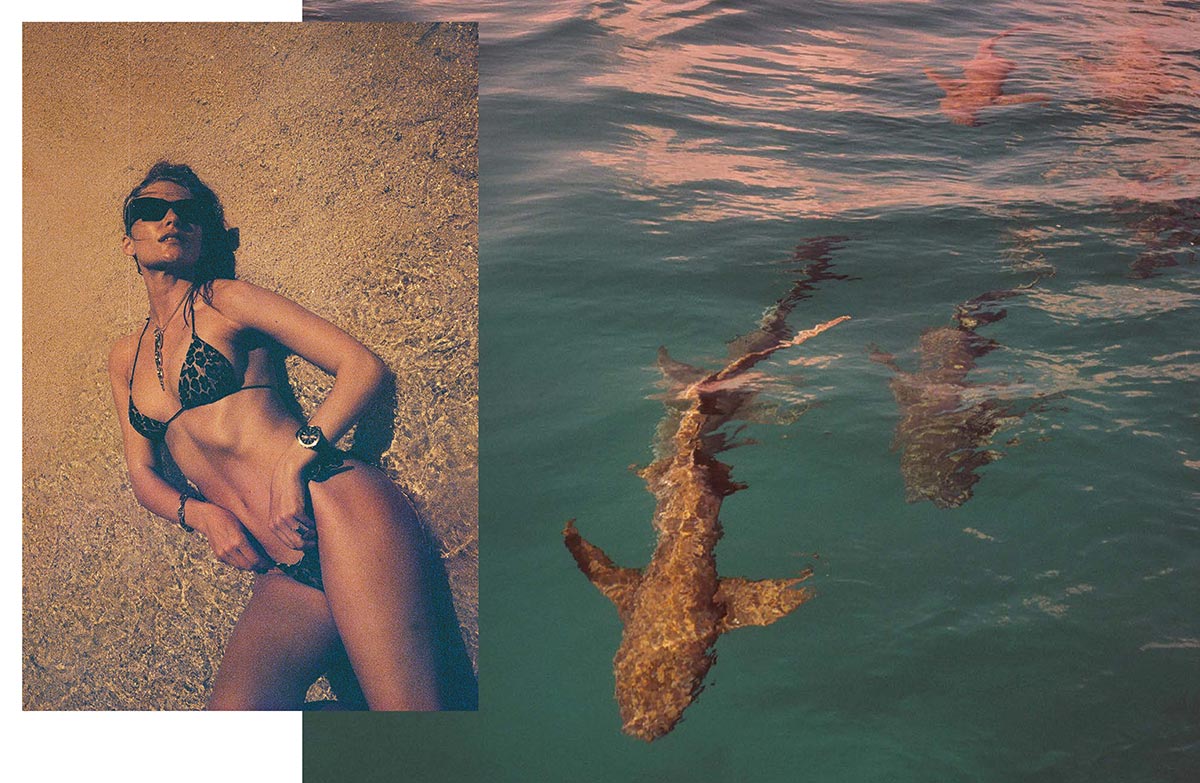
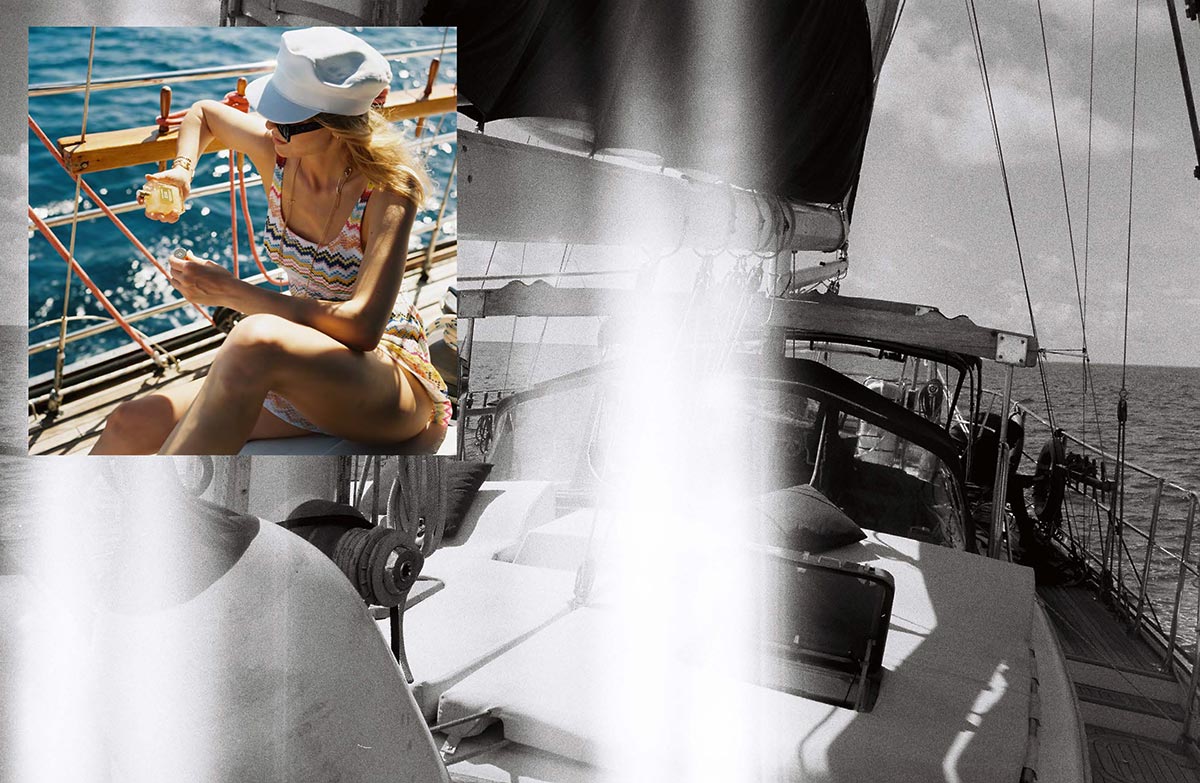
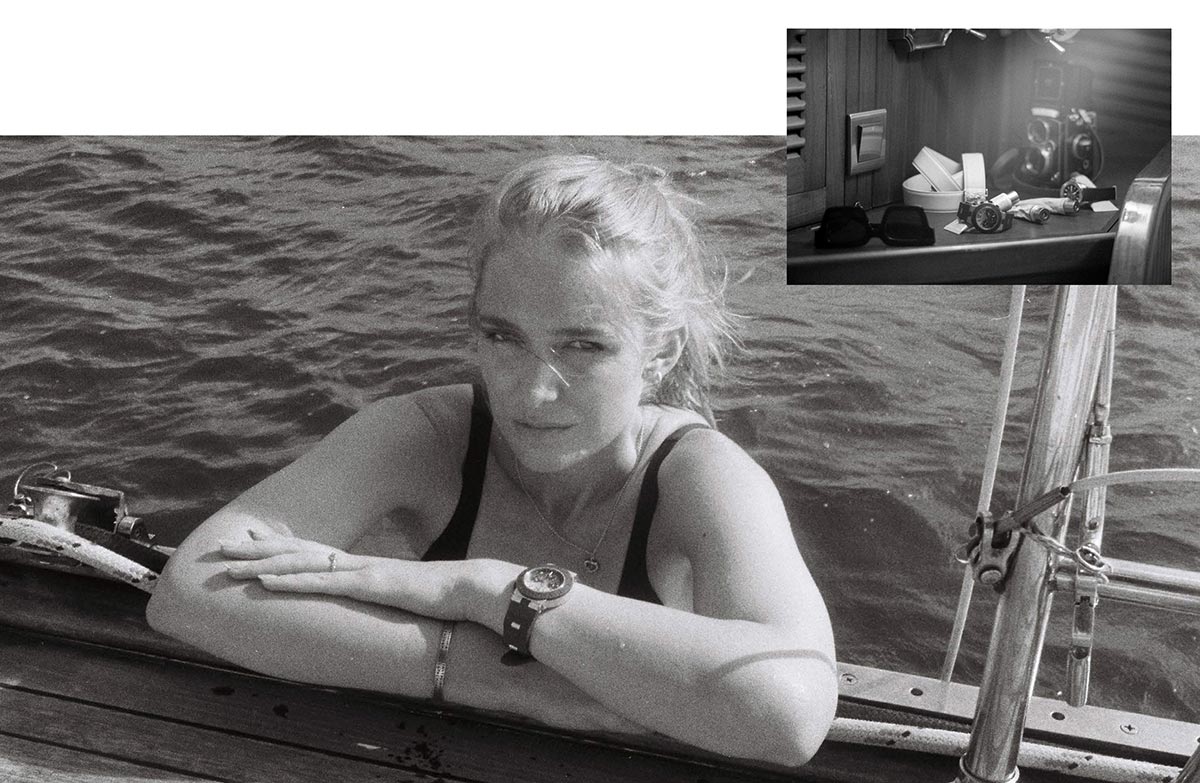
Still life:
Belt from SAINT LAURENT. Sunglasses from ROBERT LA ROCHE. Watches from BULGARI. Hand cream from ACQUA DI PARMA.
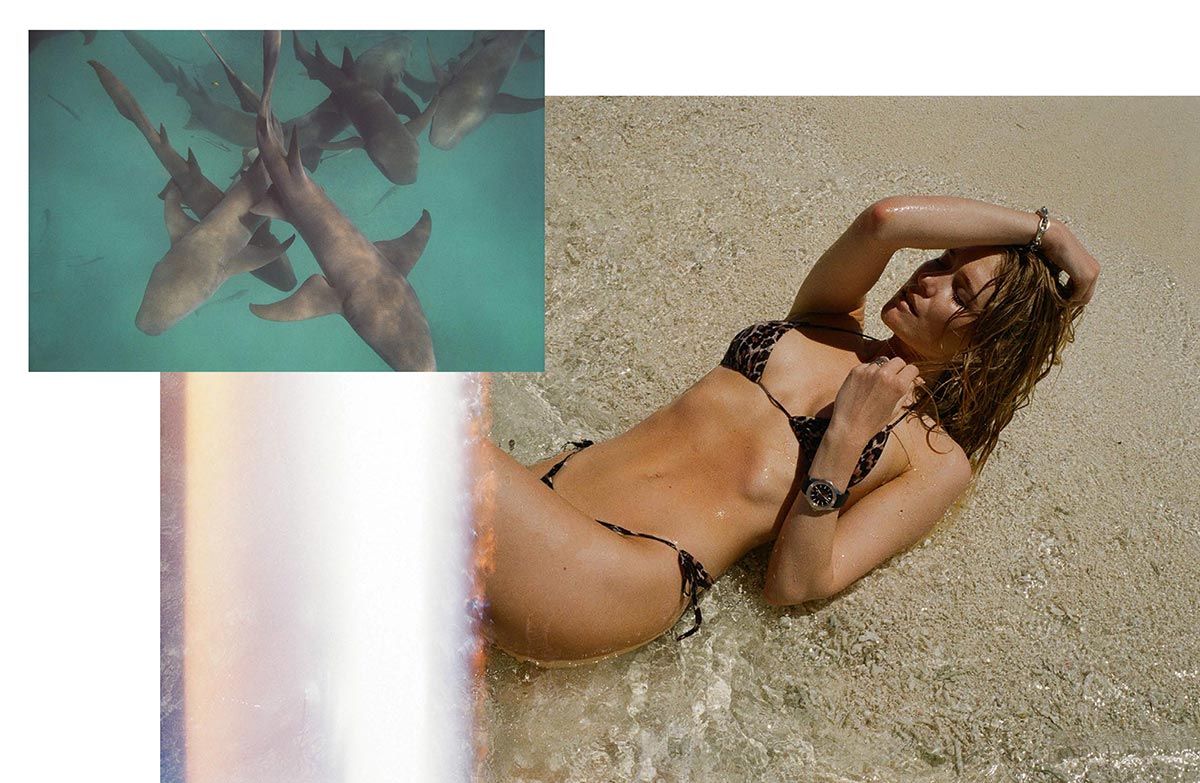
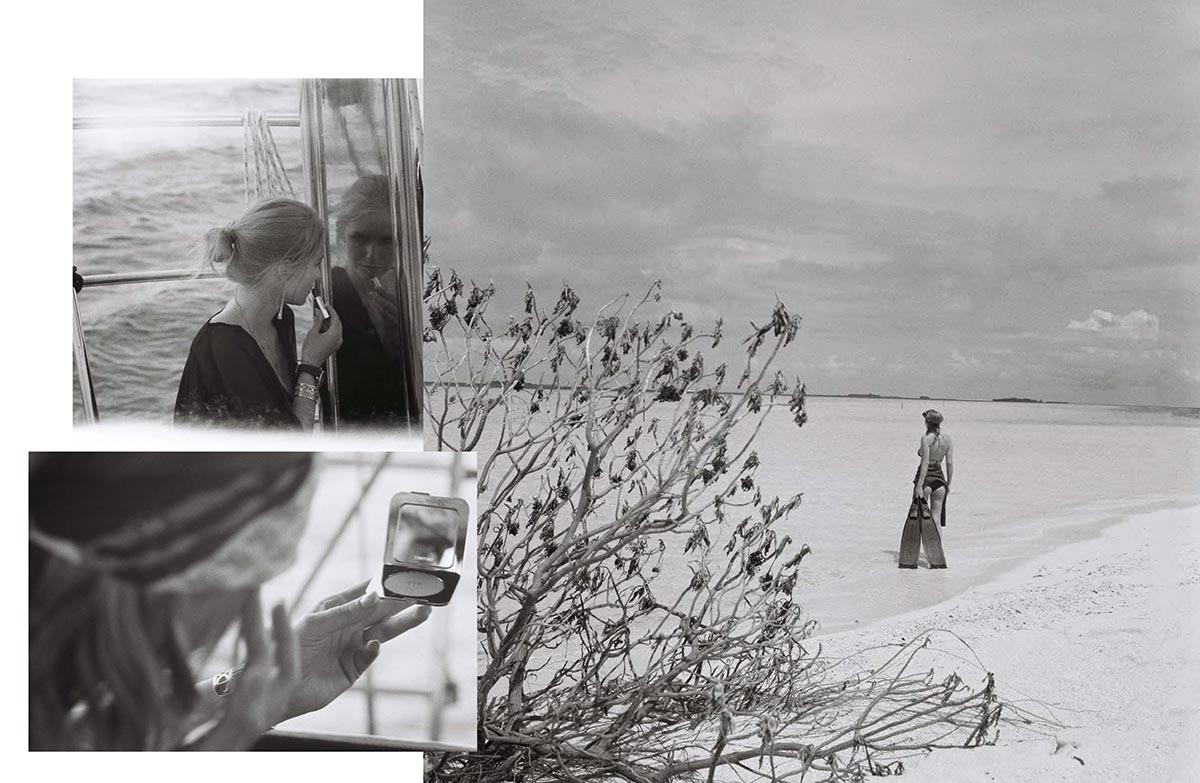
Jewelry and earrings from HERMÈS. Lipstick from CHANEL. Bronzer from TOM FORD.
Right:
Wetsuit from RIP CURL. Swimming fins CAPTAIN’S OWN.
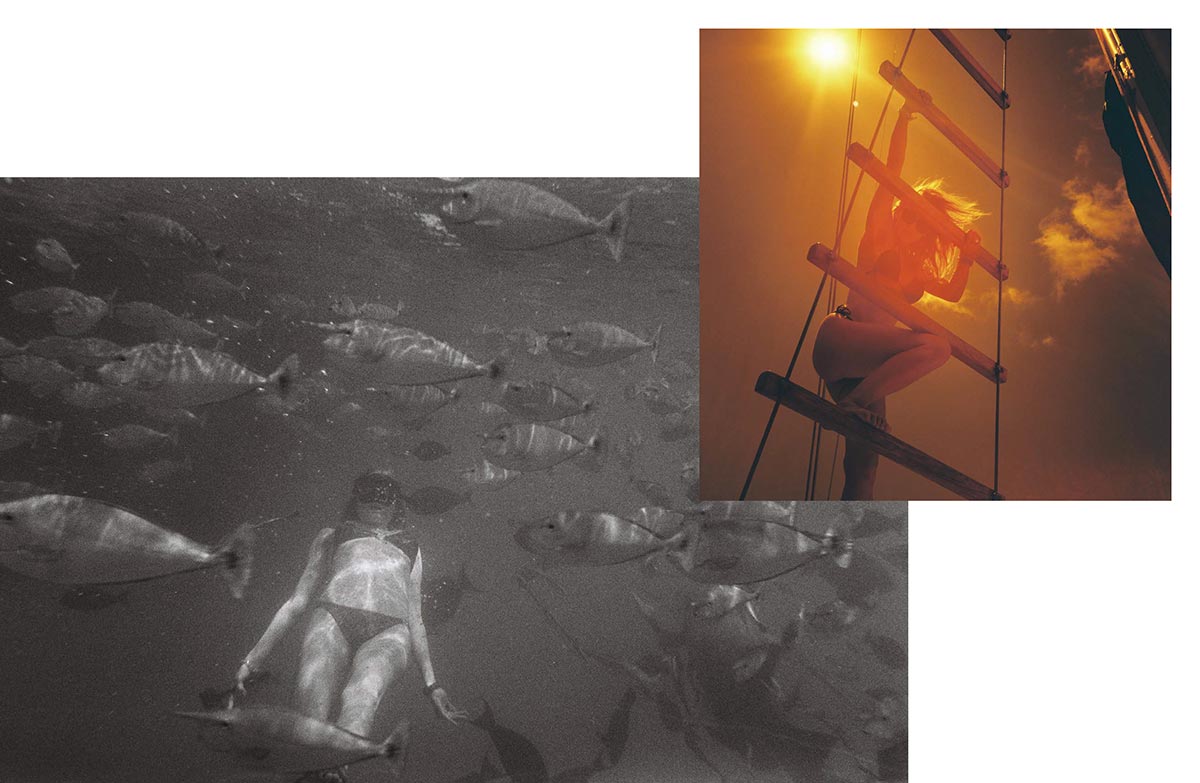
Bikini from GUCCI. Watch from BULGARI.
Right:
Bikini from TOTÊME. Sunglasses from ROBERT LA ROCHE.
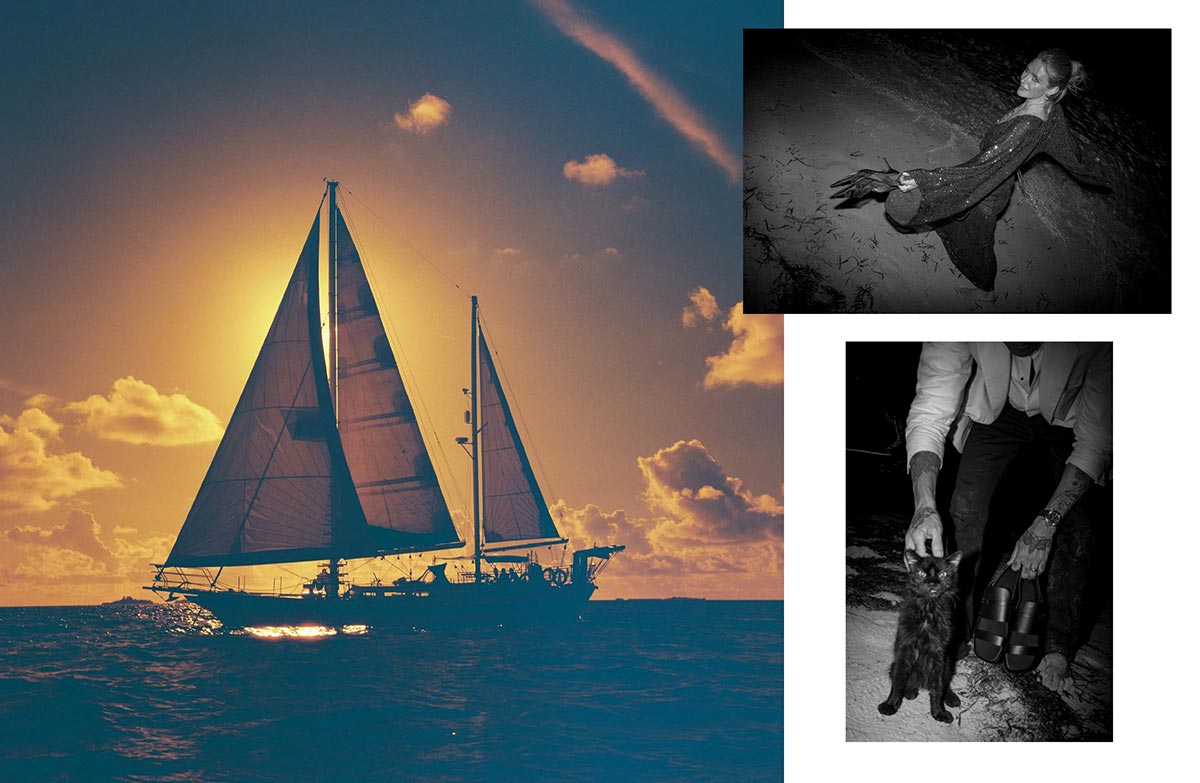
Dress by NERVI (via MAISON GASSMANN). Shoes and earrings from CHANEL.
Bottom right:
Shirt, trousers and belt from SAINT LAURENT. Jacket from RICHARD JAMES. Shoes from HERMÈS. Watch from TAG HEUER. Cufflinks from VIVIENNE WESTWOOD.
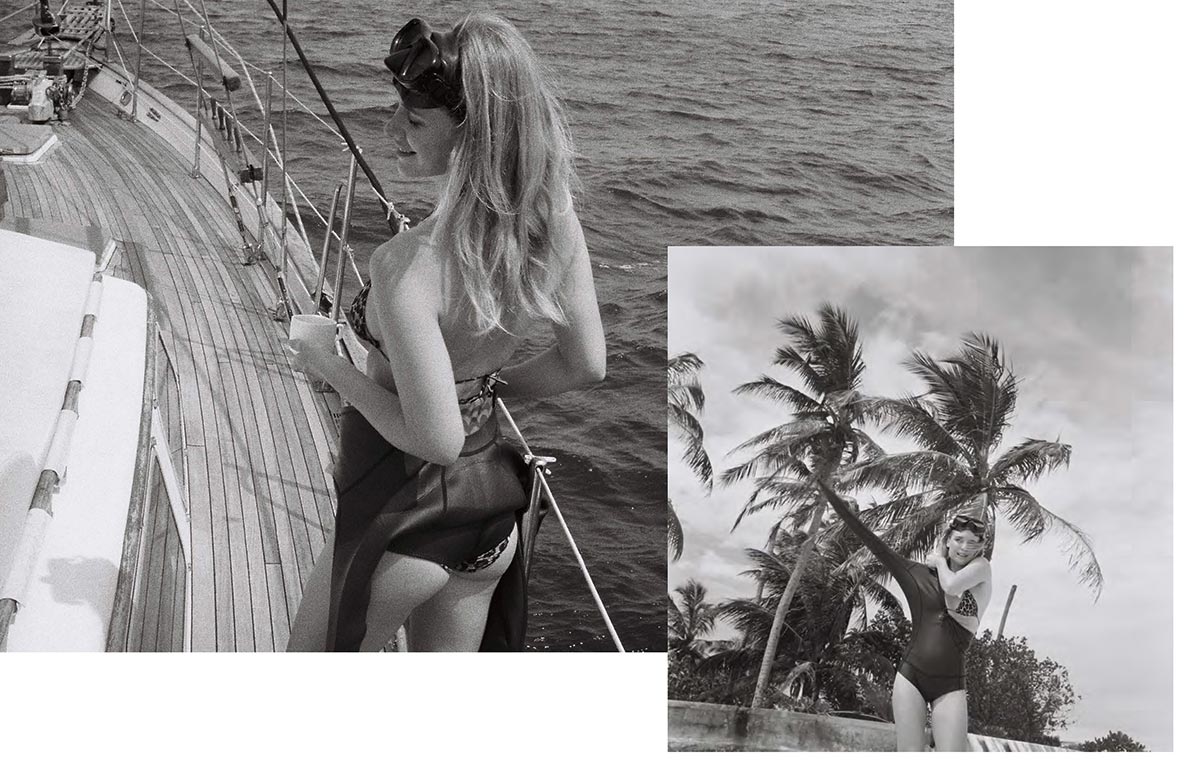
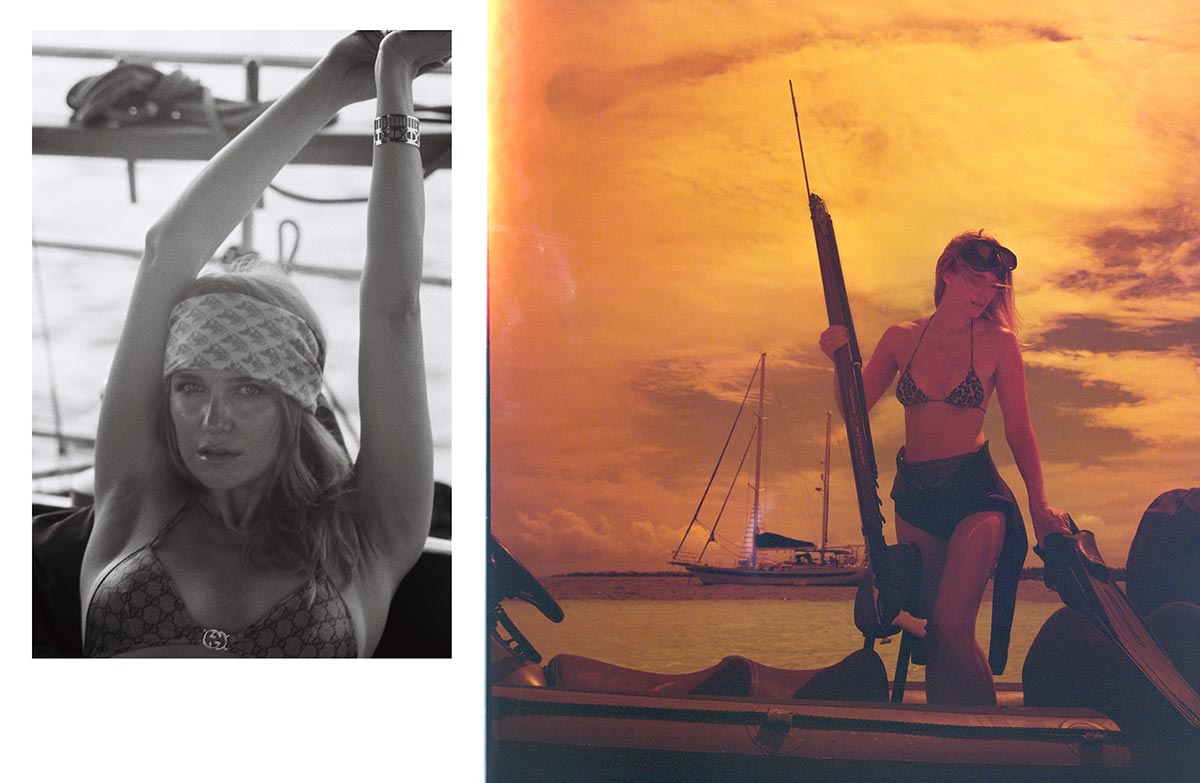
Bikini from GUCCI. Bracelet from HERMÈS. Scarf from CÉLINE. Beauty from HERMÈS and GUCCI BEAUTY.
Right:
Bikini by DOLCE & GABBANA. Wetsuit from RIP CURL.
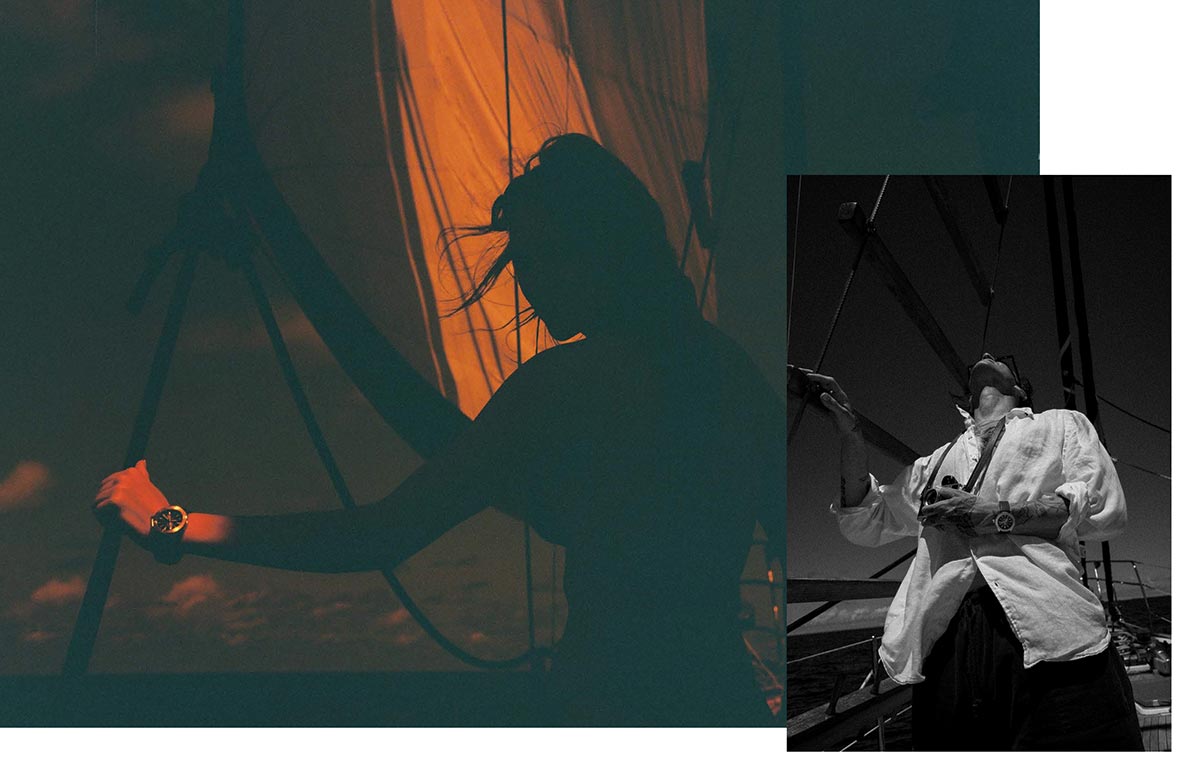
Watch from TAG HEUER.
Right:
Shirt by RALPH LAUREN. Shorts from RIVIERAS (via JELMOLI). Watch from TAG HEUER. CAMERA from LEICA.
Interview with Jasmin Brunner
As part of this shoot, we had the opportunity to talk to Jasmin Brunner about her life as a model and muse.
FACES: Jasmin, the concept of being a muse, or “musing”, is not new to you. You started modeling at a young age. Who are the most influential names you’ve worked with and how has it shaped your path and the way you work today?
Jasmin: I remember my first editorial shoots in Italy for Cosmopolitan IT, Vanity Fair, and my collaborations with houses like Dolce & Gabbana and Roberto Cavalli. I was only 19 years old and I had no idea. (Laughs). It was nerve-wracking, but also pretty exciting. I learned quickly. I have been fascinated by fashion and creative processes since I was a child.
In my job as a model, which I did full-time for over 10 years, I loved working in creative teams. Everyone in the team is a perfect piece of the puzzle that together creates a wonderful picture. I’ve learned a lot about people, about dozens of photographers and clients where everyone communicates differently, about fashion, styling, the way to present yourself in front of the camera according to different styles, and also technical aspects such as cameras, lenses, light, shadows, composition and of course wearing and moving clothes and creating shapes. It helps to understand ‘the big picture’ in order to do the job well.
What I found most interesting was the ‘mood’, i.e. the atmosphere you convey. The role you slip into, with the help of make-up artists and stylists. Among other things, as a model you are the center of attention and have to bring a good energy to the team so that there is a positive dynamic. Just like the photographer. Working on set gave me energy, no matter whether I had a sleepless night traveling or was on an editorial video set for 13 hours.
At 29, I opened a photo agency in London and managed various fashion photography productions with large teams and celebrities in LA, NYC, London and Paris. After all, I had years of experience with this and knew which ‘artist’ teams would work well together. As with traditional professions, our experience enables us to work the way we do today.
In the beginning, I was mainly involved in shoots, the marketing side of fashion. Later, in London, I had a look behind the scenes at the craftsmanship and design processes that go into the clothing collections. For example with Burberry and Vivienne Westwood. Being a part of it has made me appreciate the fashion creation process tremendously and I have developed a love for high fashion and couture.
In both examples above, you can see that in fashion, all the collaborative elements make a beautiful whole in a wonderful way. In short, you could say that I learned how to turn ideas into ‘products’.
FACES: Is that why you later founded your own fashion label?
Jasmin: The business is complex, which I was all the more aware of. But it manifested itself nonetheless. I can thank Instagram for that. During Covid I designed a ‘collaboration piece’ for a London Cashmere label. I wanted to do something that came from me and that I could share. It is biographical, a must-have piece. The idea came from my twenties when I was working in London and New York and wanted a stylish piece that was cool enough to wear to castings and jobs, but would go with me everywhere and make me feel warm and cozy at home.
Alex helped me realize this project by contributing ideas on silhouettes, technical features of the design and sports referees. We wanted the sweater to be wearable, fashionable and unique.
Instagram has given the pieces visibility. People ordered and were delighted, and Jelmoli ZH bought the collection from the very first season. That encouraged me to continue.
Sustainability is important to me, so I didn’t want to start a cheap T-shirt, jogging bottoms or bikini brand. I wanted to convey the right messages: “Buy quality pieces that last and mean something to you, be yourself, style and wear my sweaters your way”. The sweaters are dyed in non-toxic colors and Fairtrade. It is important to me that everything from the animal to the manufacturer to the carrier is responsible. I wanted to lend positivity and not create any more problems.
FACES: Let’s stay with Instagram for a moment; you work with some luxury brands such as Hermès, Bvlgari, Miele and Dior. How do you choose your partners, or how do they choose you?
Jasmin:I like customers who share the same values and appreciate my aesthetics. It’s fun to get in touch with the vision of a brand and its people, and I need to have a certain personal affinity/connection to what I’m promoting. Is it sustainable? Or is there an inspiring idea behind it? I am against fast fashion and cruelty to animals.
Social media enables brands to place their products in our authentic environment. That’s why I usually have few guidelines. This freedom is a wonderful way of working. I have a mature demographic of subscribers, and I would say that because of my background and account style, I have a lot of subscribers that are hard to reach by other influencers. I don’t follow a commercial influencer model.
I like brands with tradition and craftsmanship. Bulgari, for example, fascinates me because of their larger-than-life narratives and personal craftsmanship in every bag. Her high-jewelry collections are real works of art. The ‘Hermès’ icon harmonizes with innovative approaches and timeless, chic simplicity. They collaborate with wonderful artists and illustrators for prints and various playful activities. The storytelling, craftsmanship and design collaborations of Acqua di Parma are also totally in our world.
Miele, not only because of its strong commitment to sustainability, but also because of its commitment to art and fashion in Switzerland is indispensable. With their projects, they are helping to create role models for the next generation. This is close to my heart, as I myself grew up with the impression that successful creative career paths are limited here.
My work on social media combines some of my passions: media, visual communication, travel, fashion, photography, layout, music, etc. I don’t want to spoil it for myself by doing things that don’t suit me. Fortunately, I have alternative sources of income that allow me to stay true to myself and my subscribers and say ‘no’ to inappropriate requests.
FACES: Looking at your Instagram feed, your curated imagery is more on the artistic side. It’s not the norm and it has few Instagram ads. Was it difficult to find your creative voice?
Jasmin: I would say it’s important where influences come from. I consume art, fashion, music, books, movies and try to be more influenced by that and especially by myself, rather than too much by what others post on Instagram. Alex is of course a great influence and vice versa. I owe the photo style to him as my most frequent cooperation partner.
I have my aesthetic and my style. But of course everything evolves – there’s always something new to learn, even technically.
Instagram is a creative expression platform for me. An extension of what I have been doing all my life. I work with selected brands to create content that evokes emotions. It’s very “me” and it comes from my influences and our lifestyle.
I often have a certain romantic inspiration. I only noticed that recently. A world that I create, not only in my content, but also in my daily life. These include scents, images, places (…).
For someone like me who posts regularly, the process must be intuitive. It would be counterproductive to think about every post for too long. I don’t have a week to perfect the colors or think about the right order. It has to go faster. Social media for me has to be reasonably spontaneous and honest. Although a brand campaign takes a lot of time from start to finish, excessive perfectionism in the final selection leads to lifeless content that may not even be that interesting.
It’s the same with everything: You have to love what you do. I hope that if I publish something I like, some of you will like it too. I hope to not just bore people with perfect pictures, but maybe trigger something positive or at least add value, inspiration or encouragement like a magazine, a beautiful picture or a book can do. I often link styling articles so people know where to buy it if they like it, or give tips on where to eat or travel. But I communicate freely via pictures, not like a travel guide.
FACES: Do you follow Instagram, TikTok or social media trends? At first glance it doesn’t seem so, what do you think of this phenomenon?
Jasmin: The short answer is “no”. I think most social media trends are based on the premise of building a larger following. I think if we only chase our followers, likes and interactions, we lose ourselves …
When I see trends that I like, I ask myself whether it fits in with my storytelling. If so, why not. I don’t take myself too seriously, I stay true to my direction, but I don’t fit into a box. I am very versatile and therefore hope that it never gets boring. 🙂
Funny Reels and TikTok are used for entertainment and have a great ‘community aspect’. People communicate through it . I actually think that’s fun, even if I’m doing less of it myself at the moment, it’s about good emotions and if you can make someone laugh, that’s great.
But what bores me is when everyone posts the same style of photos/content that seem to be popular.
I would say it’s worth investing in our own uniqueness in the long term and being an original. Artificial intelligence (AI) can also copy; being a trendsetter is better. Use your innate human powers and be creative/yourself! 😀
FACES: Now for something more personal: How is it working with Alex, not only for social media, but also when you shoot international print campaigns, for example for Robert La Roche or this magazine editorial?
Jasmin: We had to learn to communicate our visual ideas with each other, to be flexible and patient. We usually start a larger project by sharing visuals and mood boards for each aspect of a shoot. Then it continues with prep, fittings, etc. We work together seamlessly until the end, when we select the images that will ultimately go into the story. We work out a lot of things in our heads and on paper weeks before a major shoot. I trust Alex when it comes to photography and tend to take care of the styling and ‘mood’/settings in preparation, he takes care of the story (especially if it’s more his project) and all the different analog-technical things, all the films, cameras etc..
Sometimes we are ‘stubborn’ because we believe in our own directorates and have to convince each other. The best thing is when we accept and try out an idea from the other person and it comes out great, I think we both love that. It’s magic.
I always know exactly which cameras, films or lenses Alex needs so that I know how to work with them. e.g. close-up lenses, or colors and redscale film. This helps me make decisions about my look, shapes, textures, etc. The briefing and planning before the shoot are generally very important so that all the right elements come together. After that, it’s actually very organic.
Because we work with so many different analog cameras and film types, there are a lot of elements to control. Alex is brilliant with it. It’s unbelievable how good you have to be with it, because you don’t see any pictures on the camera until they are developed weeks later. Of course, this also makes my job more difficult, as I can’t check what was ‘wrong’ in a picture and retake it. We therefore have to work in a very detail-oriented way. In return, the analog images are ultimately so wonderful and timeless and often perfect with zero image editing, as our FACES story is.
Nowadays, we decide to work on many projects without a team. This means we can make the most of the best light and the best moment, whether it’s 5am or 9pm, and enjoy the time between shots together without entertaining anyone. This has many positive aspects for us, also stylistically, as we can do what we like, but it also means that we have to oversee many aspects with two people, without additional eyes or hands. This requires a lot of experience and concentration.
FACES: The editorial is a mixture of fashion, beauty and lifestyle. What is the story about?
“Authenticity and realism”, paired with profound retro emotions, are important basic ideas in our productions. The photography has a sincere character and captures special moments.
Jasmin: We wanted to create an honest lifestyle piece, a real vacation. The products, the clothes or I myself should not be too dominant, but should live in their natural environment. Just like in real life, pieces are repeated and match different scenarios and outfits.
It was important for us to include some of our favorite clients and brands that we are proud to work with. It is also a kind of love letter to the brands, some of which have long believed in us, such as Hermès and Bulgari. It is difficult to quantify a connection. For example; Alex has been wearing the same Tag Heuer watch for over 25 years. It is a part of him. That’s why he wanted to include one of the brand’s latest models in this shoot, and god, the watch is beautiful! A rose gold piece, absolutely gorgeous on me too. I like wearing men’s watches. I own a Rolex DateJust and wear it every day. It was my engagement present. In the evening, when it’s more elegant, I sometimes like a Serpenti watch. Unfortunately, I don’t own any (yet), but I sometimes borrow pieces from Bulgari for special occasions. For the shoot we had a beautiful new Bulgari aluminum sports watch with us, which was perfect for the sailing trip. We used it to take some snorkeling underwater shots with nurse sharks and a manta ray. The genius. As you can see, these are all real applications.
FACES: What advice would you give to younger people who want to get started in this industry? For example as a photographer, stylist or model.
Jasmin: What I could say is, follow your heart, gut feeling and intuition. If you have a goal in mind and work towards it, things should happen. Of course you have to be proactive. Small steps lead to bigger things, detours are fine. Just go out there. Self-doubt is useless. It is important to learn from each other, build valuable relationships and work on yourself.
You can also find the hottest fashion and greatest shoots here.
